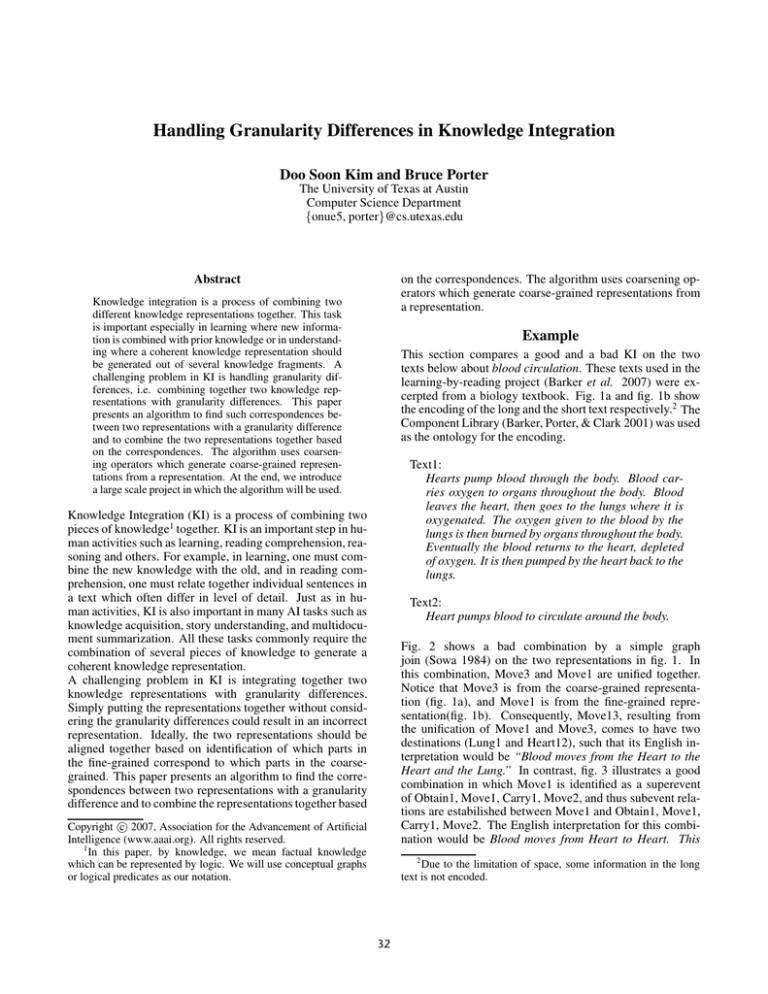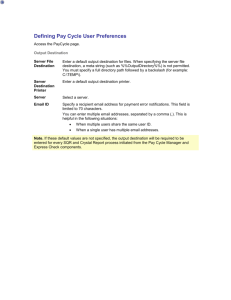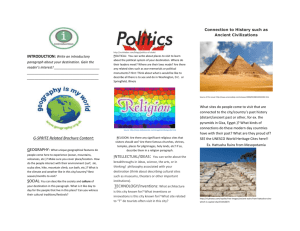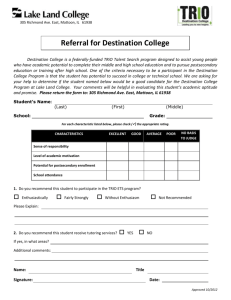
Handling Granularity Differences in Knowledge Integration
Doo Soon Kim and Bruce Porter
The University of Texas at Austin
Computer Science Department
{onue5, porter}@cs.utexas.edu
on the correspondences. The algorithm uses coarsening operators which generate coarse-grained representations from
a representation.
Abstract
Knowledge integration is a process of combining two
different knowledge representations together. This task
is important especially in learning where new information is combined with prior knowledge or in understanding where a coherent knowledge representation should
be generated out of several knowledge fragments. A
challenging problem in KI is handling granularity differences, i.e. combining together two knowledge representations with granularity differences. This paper
presents an algorithm to find such correspondences between two representations with a granularity difference
and to combine the two representations together based
on the correspondences. The algorithm uses coarsening operators which generate coarse-grained representations from a representation. At the end, we introduce
a large scale project in which the algorithm will be used.
Example
This section compares a good and a bad KI on the two
texts below about blood circulation. These texts used in the
learning-by-reading project (Barker et al. 2007) were excerpted from a biology textbook. Fig. 1a and fig. 1b show
the encoding of the long and the short text respectively.2 The
Component Library (Barker, Porter, & Clark 2001) was used
as the ontology for the encoding.
Text1:
Hearts pump blood through the body. Blood carries oxygen to organs throughout the body. Blood
leaves the heart, then goes to the lungs where it is
oxygenated. The oxygen given to the blood by the
lungs is then burned by organs throughout the body.
Eventually the blood returns to the heart, depleted
of oxygen. It is then pumped by the heart back to the
lungs.
Knowledge Integration (KI) is a process of combining two
pieces of knowledge1 together. KI is an important step in human activities such as learning, reading comprehension, reasoning and others. For example, in learning, one must combine the new knowledge with the old, and in reading comprehension, one must relate together individual sentences in
a text which often differ in level of detail. Just as in human activities, KI is also important in many AI tasks such as
knowledge acquisition, story understanding, and multidocument summarization. All these tasks commonly require the
combination of several pieces of knowledge to generate a
coherent knowledge representation.
A challenging problem in KI is integrating together two
knowledge representations with granularity differences.
Simply putting the representations together without considering the granularity differences could result in an incorrect
representation. Ideally, the two representations should be
aligned together based on identification of which parts in
the fine-grained correspond to which parts in the coarsegrained. This paper presents an algorithm to find the correspondences between two representations with a granularity
difference and to combine the representations together based
Text2:
Heart pumps blood to circulate around the body.
Fig. 2 shows a bad combination by a simple graph
join (Sowa 1984) on the two representations in fig. 1. In
this combination, Move3 and Move1 are unified together.
Notice that Move3 is from the coarse-grained representation (fig. 1a), and Move1 is from the fine-grained representation(fig. 1b). Consequently, Move13, resulting from
the unification of Move1 and Move3, comes to have two
destinations (Lung1 and Heart12), such that its English interpretation would be “Blood moves from the Heart to the
Heart and the Lung.” In contrast, fig. 3 illustrates a good
combination in which Move1 is identified as a superevent
of Obtain1, Move1, Carry1, Move2, and thus subevent relations are estabilished between Move1 and Obtain1, Move1,
Carry1, Move2. The English interpretation for this combination would be Blood moves from Heart to Heart. This
c 2007, Association for the Advancement of Artificial
Copyright Intelligence (www.aaai.org). All rights reserved.
1
In this paper, by knowledge, we mean factual knowledge
which can be represented by logic. We will use conceptual graphs
or logical predicates as our notation.
2
Due to the limitation of space, some information in the long
text is not encoded.
32
instrument
path
origin
Move1
object
object
destination
Heart1
Pumping1
causes
Conduit1
Heart2
destination
next-event
instrument
Blood1
origin, destination
Move2
causes
object
Pumping2
next-event
Lung1
base
agent
Move3
next-event
object
object
site
next-event
path
Obtain1
object
Blood2
Body1
Carry1
destination
object
Organ1
Oxygen1
(b) coarse-grained representation
(a) fine-grained representation
Figure 1: Encodings on the two texts on blood circulation: The fine-grained is shown in the left and the coarse-grained in the
right.
Heart2
origin
Heart1
origin, destination
+
destination
Move1
Move3
object
Lung1
Move3
subevent
Blood2
Blood1
object
(Blood moves from the Heart to the Heart)
(Blood moves from the Heart to the Lung)
origin,
destination
causes
object
subevent
instrument
Conduit1
Pumping12
Heart12
causes
origin
path
Heart12
origin,destination
destination
destination
Move13
subevent
destination
object
Move1
next-event
object
Blood12
object
Move1
object
Lung1
Blood1
next-event
base
Lung1
agent
next-event
site
(Blood moves from the Heart to the Lung and the Heart)
path
next-event
Obtain1
Figure 2: Bad combination of the two representations
in fig. 1 by a simple graph join (Sowa 1984). English
glosses are given below each representation. Because
of the space limitation, the relevant parts of the represetations from fig. 1 are shown. In this combination,
Move1 and Move3 are unified, and consequently the resulting node, Move13, has two destinations, Lung1 and
Heart12. (<name><number1><number2> labels a node
created by the unification of <name><number1> and
<name><number2>. For example, Move13 is a node created by the unification of Move1 and Move3.)
Body1
Carry1
object
object
Oxygen1
destination
Organ1
: subevent relations infered by the algorithm
: relations from the encodings in figure. 1
Figure 3: Good combination of the two representations in
fig. 1 using our algorithm. Move3 is identified as a superevent of Move1, Obtain1, Carry1, and Move2
33
movement has 4 subevents: Blood moving to the lung, Blood
obtainining oxygen, Blood carrying oxygen, and Blood moving to the heart.
origin
object
next-event
Move
(before)
Difficulties in handling granularity differences
in KI
path
next-event
Obtain
destination
object
Lung
We confine ourselves in this section to the difficulties in handling granularity differences, although there are other difficult problems in KI (Murray 1995).
body
Oxygen
Heart
Circulate
base
object
Blood
body
Heart
origin
path
next-event
• finding correspondences between the fine-grained and
the coarse-grained The parts in the fine-grained that are
detail descriptions of parts in the coarse-grained should
be identified. Just putting them together without this consideration could produce an incorrect representation as in
fig. 2.
• revealing unspecified relations The unspecified relations
between the fine-grained and the coarse-grained should
be explicitly represented in the combined representation.
For example, given “The heart pumps blood around the
body” and “The right ventricle contracts blood to the
lung,” the combined representation has to represent explicitly that the RIGHT VENTRICLE is a part of the HEART,
the CONTRACT action is a subevent of the PUMPING action, the LUNG is a part of the BODY. The more related
they are, the more useful the combined knowledge would
be.
• resolving corefered entities Entities corefered by different representations should be identified. For example, in
fig. 1, BLOOD, HEART, and P UMPING are entities corefered by the two representations.
Move
(after)
Circulate
destination
object
Lung
object
Blood
Figure 4: Example of filtering: To pick up oxygen is filtered
out.
Coarsening operators
The coarsening operators convert a fine-grained representation into a more coarse-grained one. (Stell & Worboys
1999) and (Ramalingam & Hornsby 2001) identified a similar type of coarsening operators to handle spatial granularity
differences.
We defined three types of coarsening operators: filtering,
generalization, and abstraction. Each type is represented as
a rule. The antecedent of a rule represents a pattern that is
coarsened, and the consequent represents the result of coarsening the antecedent. By matching an antecedent of a rule
with a part of a knowledge representation and replacing the
part with the consequent, the representation can be transformed into a more coarse-grained one.
Each rule will be illustrated with a diagram in which nodes
denote instances, and edges denote relations among the instances. The corresponding logical notation is provided.
Problem description and Algorithm
This section presents a KI algorithm to handle granularity differences. The algorithm takes in two representations
which represent the same topic: a fine-grained representation and a coarse-grained representation. The algorithm
coarsens the granularity of the fine-grained representation
repeatedly until there is an enough graph match (Sowa 1984)
between the coarsened fine-grained representation and the
coarse-grained representation (Algorithm1).
1. Filtering
Some of the information in a representation can be filtered
out in a coarse granularity.
r
Algorithm 1 Finding correspondences between two representations with granularity differences
Input : Kf ine , a fine-grained representation
Kcoarse , a coarse-grained representation
Output : combined knowledge representation
Algorithm
while Kf ine is not matched with Kcoarse well
enough (Sowa 1984) do
Kf ine ← transform Kf ine into a more coarse-grained
represenation using the coarsening operators.
Keep the information of how Kf ine gets transformed.
end while
Combine Kf ine and Kcoarse together based on the transformation information recorded during the coarsening.
Y
X
r(X, Y)
X (or Y)
X ( or Y)
Some of information associated with the filtered nodes
such as their properties and their partonomical descedents
should be also filtered out.
Example
(before) The blood flows from the heart to the lung to
pick up oxygen3 and then circulates around the body.
(after) The blood flows from the heart to the lung and
then circulates around the body.
3
Throughout the examples, italic words represent the coarsened
parts
34
conduit
Fig. 4 shows the example in a conceptual graph notation.
To prevent any part of a representation from being filtered
out, it is necessary to determine which parts are allowed to
be left out. For example, “The blood picks up oxygen and
then circulates around the body”, resulting from filtering out
“The blood flows from the heart to the lung” from the above
example, is not a good description of blood circulation. For
now, we leave this problem as our future research problem.
We speculate that coherence plays an important role. In the
example, FLOW is coherent with CIRCULATE in that they
together represent the continuation-of-movement viewpoint,
whereas PICK - UP and CIRCULATE do not constitue any coherent viewpoint.
Atrium
Heart
Ventricle
Figure 5: A picture to illustrate the example. Atrium and
ventricle are abstracted into heart.
All relations associated with X and Y can be carried over to
Z.
functional abstraction Functional domains describe
events and temporal relations among them.
2. Generalization
r
Y
X
A few specific descriptions can be generalized into a more
general description.
Z
X, Y : Events in a subclass relation
r : next-event
Z is a superevent (or superclass)
or X and Y
r(X,Y)
r
conduit
conduit
conduit
Z
Y
r
X
P
X
r
Example
(before)Jack moves from LA to Chicago, and then
moves from Chicago to NY.
(after) Jack moves from LA to NY.
Z
P is a superpart(or superclass) of Y and Z
r(X,Y) & r(X,Z)
r(X,P)
Some relations associated with X and Y should be prohibited
from being carried over to Z if they describe a state which
results from the event X but are overriden by the event Y.
In the above example, Chicago is an intermediate location
which is nullified later by the next move.
Example
(before) The right ventricle is below the right atrium
in a heart. The left ventricle is below the left atrium in
a heart.
(after) A ventricle is below the atrium in the heart.
causal abstraction Causal domains describe events and
causal relations among them.
Only common relations from Y and Z are carried over to P.
r
Y
3. Abstraction
X
A detail description can be abstracted out. This abstraction
looks slightly different in different domains.
X, Y : events
r : causal relation
r(X, Y)
X (or Y)
X (or Y)
structural abstraction Structural domains describe physical objects and relations among them.
Example
(before) John mixed oxygen and hydrogen together. As
a result, water was produced.
(after)
1. Mixing together oxygen and hydrogen by John produced water.
2. Water is produced out of oxygen and hydrogen by
John.
r
Y
X
X, Y : physical objects
r : structural relations such as
is-beside, near, etc
Z
Z is a superpart(or superclass)
of X and Y
Z
r(X,Y)
The difference from the above two cases is that either X or
Y is chosen in the consequent. Fig. 6 shows two ways of
abstracting the before text in the example.
If the cause (X in the above diagram) is retained in the consequent, the information associated with Y should not be
carried over except the information describing effects by Y.
In the example, (result water) is carried over(the dotted line
in fig. 6b). If the effect (Y in the diagram) is retained in
Example
(before) A blood conduit is connected to an atrium. An
atrium is above a ventricle. A ventricle is connected to
another blood conduit.
(after) A blood conduit is connected to a heart, which
is connected to another conduit.
35
In the above example, the two knowledge representations
have different destinations (Austin and Texas respectively),
though both express the same meaning. These destinations are different in the level of granularity. (Yeh, Porter,
& Barker 2003) identified a similar type of rules called
“transfers-thru” in their library of transformation rules.
(a)
John
Oxygen
agent
object
result
causes
Mix
(before)
Produce
water
object
Handling granularity difference as state space
search
Hydrogen
(c)
(b)
The operators in the previous section can coarsen a finegrained representation in many different ways. To handle
multiple possible outputs, we reformulate our problem as a
state space search. We will use Gf ine and Gcoarse to denote
a fine-grained representation and a coarse-grained representation to be matched, respectively.
Hydrogen
Oxygen
John
Oxygen
raw-material
raw-material
object
agent
(after)
result
Produce
Mix
object
result
water
agent
Hydrogen
water
•
•
•
•
John
Figure 6: Two ways of abstracting the before text in the
example.
the consequent, only information describing the cause of X
such as an agent of X or a causal event of X should be carried over. In the example, (agent John), (raw-material Oxygen) and (raw-material Hydrogen) are carried over (the dotted lines in fig. 6c)
As in other search-based methods, it would suffer from the
state explosion problem. One heuristic of preventing the
state explosion is to use the coarse-grained input as a guidance for the search. For example, the coarsening operators
may be restricted to apply only to unmatched parts between
the fine-grained and the coarse-grained.
4. Referring at different level of granularity
A same thing can be referred at different level of granularity.
r1
Working Example
Fig. 8 illustrates a sequence of transformations of the finegrained representation in fig. 1a. This sequence would be
a solution path in a state space search. The figure shows
that the transformed representation finally comes to have the
same granularity as the coarse-grained. Based on the transformation records kept during the transformations, our algorithm is able to estabilish the subevent relations between the
events in the two representations. Fig. 3 shows the KI result
on the two representation in fig. 1 by our algorityhm based
on the transformation records.
r1
r2
Y
X
Z
X
Z
r1(X, Y) & r2 (Y, Z)
r1 (X, Z)
r2 is a relation such as partonomy
Example
(before) John moves to Austin. Austin is a part of
Texas.
(after) John moves to Texas.
Application to Learning-by-Reading
Learning-by-Reading is a large scale project in which the
goal is developing a system to build a knowledge base by
reading a text. In the system, the role of the KI module is
to integrate together logical forms generated by the NL system. Please see (Barker et al. 2007) for details. Failure of
handling granularity differences in logical forms during KI
was one of the brittlenesses in last year’s system. For example, the topic sentence of a paragraph is typically coarsegrained and the subsequent ones are more detailed. We plan
to overcome this brittleness by incorporating the algorithm
presented in this paper. The coarsening operators surfaced
with the Component Library will be used. Then, how much
the readibility is increased by our algorithm will be evaluated by measuring the correctness of the representation integrated out of logical forms.
Move
object
(before)
destination
is-part-of
John
Austin
Texas
Move
object
destination
(after)
John
Initial state A pair of Gf ine and Gcoarse
State A pair of the coarsened Gf ine and Gcoarse
Operators Coarsening operators
Goal Succeed if Gf ine and Gcoarse in the pair are
matched to each other well enough with a conceptual
graph match (Sowa 1984).
Texas
Figure 7: The destinations of M OVE are different in the level
of detail. Two relations, DESTINATION and IS - PART- OF,
gets abstracted into DESTINATION
36
instrument
Pumping1
instrument
Heart1
causes
Conduit1
Pumping1
Conduit1
origin
path
object
destination
next-event
object
Move1
destination
origin
path
filtering
Blood1
Move2
destination
Heart1
causes
Blood1
object
Move2
object
object
next-event
Lung1
base
agent
destination
next-event
object
Move1
Lung1
next-event
agent
next-event
next-event
site
next-event
path
Body1
Carry1
Obtain1
object
Carry1
destination
object
Oxygen1
destination
Organ1
instrument
Conduit1
Pumping1
Heart1
instrument
Conduit1
causes
Pumping1
path
Heart1
causes
origin
Move1
destination
next-event
object
destination
Body1
object
Organ1
Oxygen1
elaboration
path
path
origin
Blood1
Move1
destination
object
next-event
object
filtering
Move2
object
Blood1
Move2
object
Lung1
agent
base
next-event
agent
next-event
next-event
path
Carry1
subevent
object
object
Lung1
next-event
Hold3
destination
Body1
object
object
destination
Oxygen1
object
Body1
destination
Oxygen1
Organ
subevent
path
Carry1
object
Organ1
subevent
destination
Move3
destination
Move3
instrument
Conduit1
Pumping1
Heart1
instrument
causes
Pumping1
path
Heart1
Conduit1
origin
replacement
next-event
object
Move1
destination
causes
destination
object
origin
object
Move2
path
Move4
Body1
object
Lung1
path
abstraction
Blood1
object
next-event
next-event
Blood1
object
next-event
destination
Move2
object
Move3
destination
path
destination
Body1
next-event
Organ1
Organ1
instrument
Pumping1
causes
Heart1
<transformation record>
1. Obtain1 filtered out, Carry1 selected
2. Carry1 replaced by Move3
3. Move4 is a superevent of Move1, Move3
4. Move5 is a superevent of Move2, Move4
object
abstraction
Blood1
origin,
destination
object
Move5
path
path
Conduit1
Body1
Figure 8: The fine-grained representation gets coarsened repeatedly by the coarsening operators until being aligned with the
coarse-grained input well enough by the conceptual graph match (Sowa 1984). The gray nodes are the ones on which the
operators are applied. From the transformation records, which keep the information on how the fine-grained has been converted,
we can infer that Move5 is a superevent of Obtain1, Move1, Move2 and Carry1. The above figure contains two operations which
are not decribed in this paper: elaboration and replacement. Elaboration is an operation where more knowledge is added to
elaborate a concept. In the above example, C ARRY is elaborated as having H OLD and M OVE as its subevent. Replacement
is an operation to replace a concept with its partonomical child. In the example, C ARRY is replaced with M OVE, which is a
subevent of the C ARRY
37
Acknowledgments
This research was funded by DARPA under contract
NBCHD030010.
References
Barker, K.; Agashe, B.; Chaw, S. Y.; Fan, J.; Glass, M.;
Hobbs, J.; Hovy, E.; Israel, D.; Kim, D. S.; Mulkar, R.;
Patwardhan, S.; Porter, B.; Tecuci, D.; and Yeh, P. 2007.
Learning by reading: A prototype system, performance
baseline and lessons learned. In Proceedings of TwentySecond National Conference on Artificial Intelligence.
Barker, K.; Porter, B.; and Clark, P. 2001. A library
of generic concepts for composing knowledge bases. In
Proceedings of the international conference on Knowledge
capture, 14–21. ACM Press.
Murray, K. S. 1995. Learning as Knowledge Integration.
Ph.D. Dissertation, The University of Texas at Austin, Department of Computer Sciences.
Ramalingam, C., and Hornsby, K. 2001. Generalizing
graphs using amalgamation and selection. In Proceedings
of the First COSIT Workshop on Spatial Vagueness, Uncertainty, and Granularity.
Sowa, J. 1984. Conceptual Structures. Addison-Wesley.
Stell, and Worboys. 1999. Generalizing graphs using
amalgamation and selection. In SSD: Advances in Spatial
Databases. LNCS, Springer-Verlag.
Yeh, P. Z.; Porter, B.; and Barker, K. 2003. Using transformations to improve semantic matching. In Proceedings of
the international conference on Knowledge capture, 180–
189.
38





